If you’re planning a trip to Rome and looking for ideas to add to your itinerary, you’re in luck. Here’s my guide to the 16 most beautiful churches in Rome, which are among the top attractions in the city.
Rome is a powerhouse when it comes to art and architecture, and its churches are no exception.
From the Romanesque, Gothic, Renaissance, and Baroque periods, Rome’s churches showcase some of the world’s most stunning works of art and architectural styles. In particular, Rome’s churches are especially rich in Baroque era decoration.
There are an astonishing 900 churches in Rome, making it impossible to cover them all in a single blog post.
To help you narrow down your options and inspire your travels, this guide focuses on what I believe are the 16 most interesting and beautiful churches in Rome – the essential ones you simply must visit.
Even if you’re not particularly religious, the magnificence of the art and architecture alone make these churches worthy additions to your Rome itinerary or bucket list.
So get ready to be awed and inspired by the beauty and grandeur of Rome’s most stunning churches.
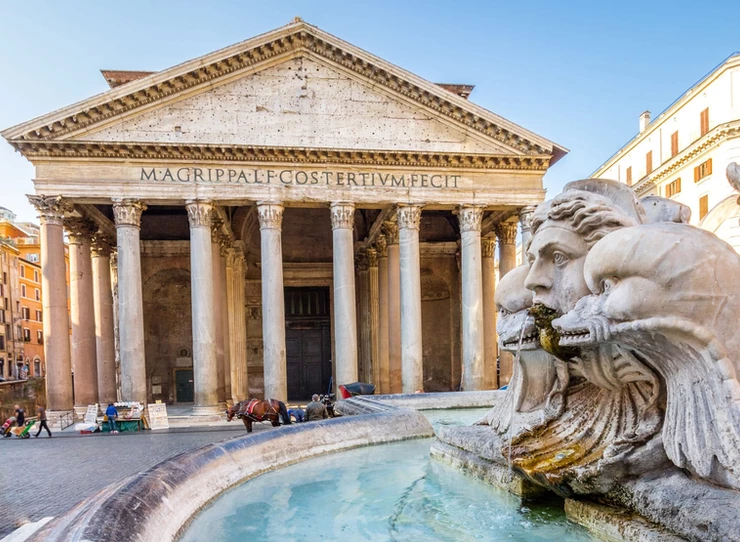
Most Beautiful Churches in Rome
Here are my picks for the best and most beautiful churches to visit in Rome. Some of these churches are among Rome’s must visit attractions. Others are sweet hidden gems in Rome hiding in plain sight.
1. Pantheon
Without a doubt, the Pantheon is the best preserved building from ancient Rome. The Pantheon was a temple dedicated to all of the gods.
It was originally built by Augustus’ right hand man, Marcus Agrippa, in 27 BC. But Agrippa’s version was destroyed by fire.
READ: Guide To Ancient Ruins in Rome
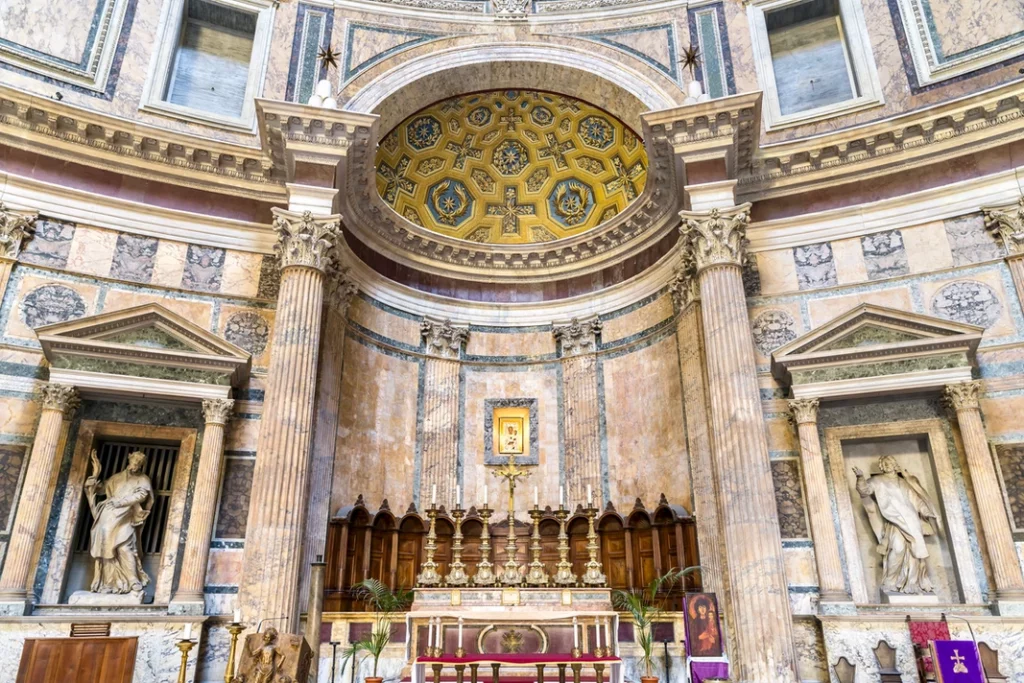
In 120 AD, the Pantheon was rebuilt by Hadrian.
READ: History of the Roman Emperors
The well-traveled emperor, a true Grecophile, reimagined it as an oversized Greek temple — with 40 foot tall Corinthian granite columns from Egypt, a pediment, and portico.
It was considered a masterpiece of engineering and mathematical precision.
The Pantheon’s most emblematic feature is its perfect unsupported spherical dome. At the time, it was a major architectural breakthrough.
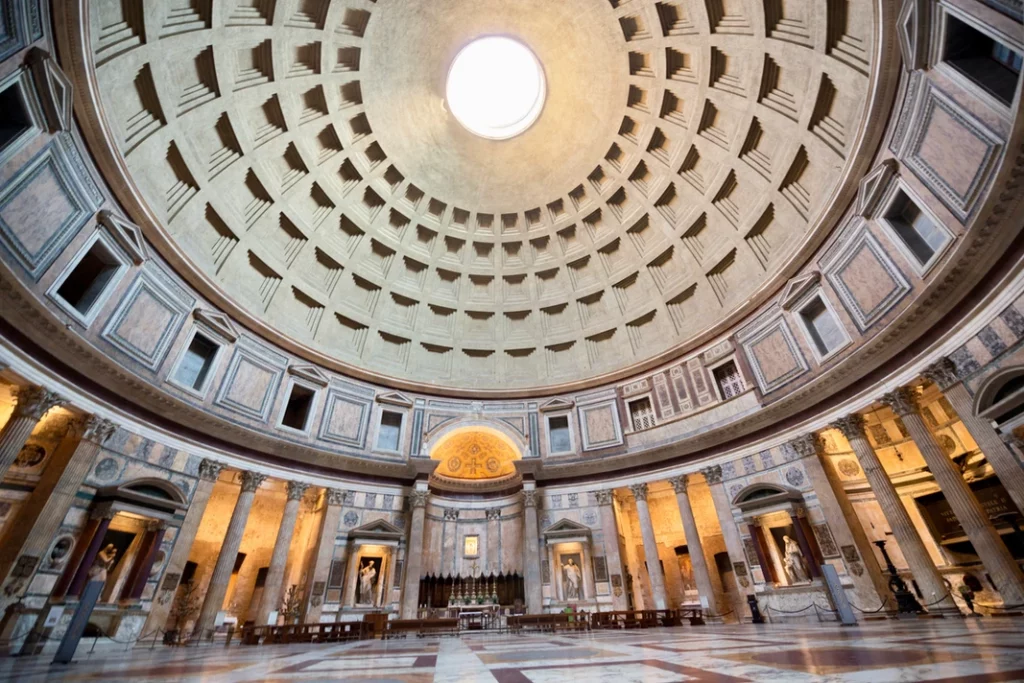
The dome became the model for Michelangelo’s dome for St. Peter’s Basilica and for Brunelleschi’s dome for Florence Cathedral. At the top is the oculus, or eye, which is the Pantheon’s only source of natural light.
After the fall of Rome, the Pantheon became a Christian church, which helped save it from looting at first. But eventually the interior, marble, and gold were all looted in the 7th century, although the marble floor is now lovingly recreated.
The Pantheon is filled with tombs of important Romans, including famed Renaissance artist Raphael.
Here’s my complete guide to the Pantheon. The Pantheon used to be free to visit. But that changed in July 2023. To avoid a long wait, you’ll need to book a skip the line ticket. Click here to book a 1 hour guided tour of the Pantheon.
READ: Guide To Raphael’s Famous Paintings
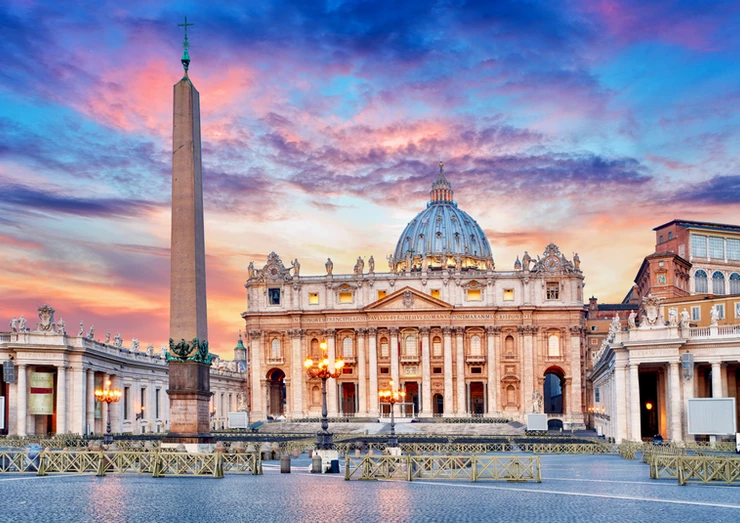
2. St. Peter’s Basilica
St. Peter’s Basilica is Rome’s most beautiful church. In fact, it’s the most famous church in Christendom.
Designed by Bramante, Raphael, and Michelangelo, it’s a true Renaissance masterpiece. It may be the most ornate space you’ve ever stepped foot in, filled with precious treasures and grandiose decoration.
St. Peter’s Basilica was completed after 120+ years of construction, the reign of 18 different popes, incalculable cost, and the direction of 12 different architects. Measuring more than two football fields in length, it’s by far the largest church in Christendom.
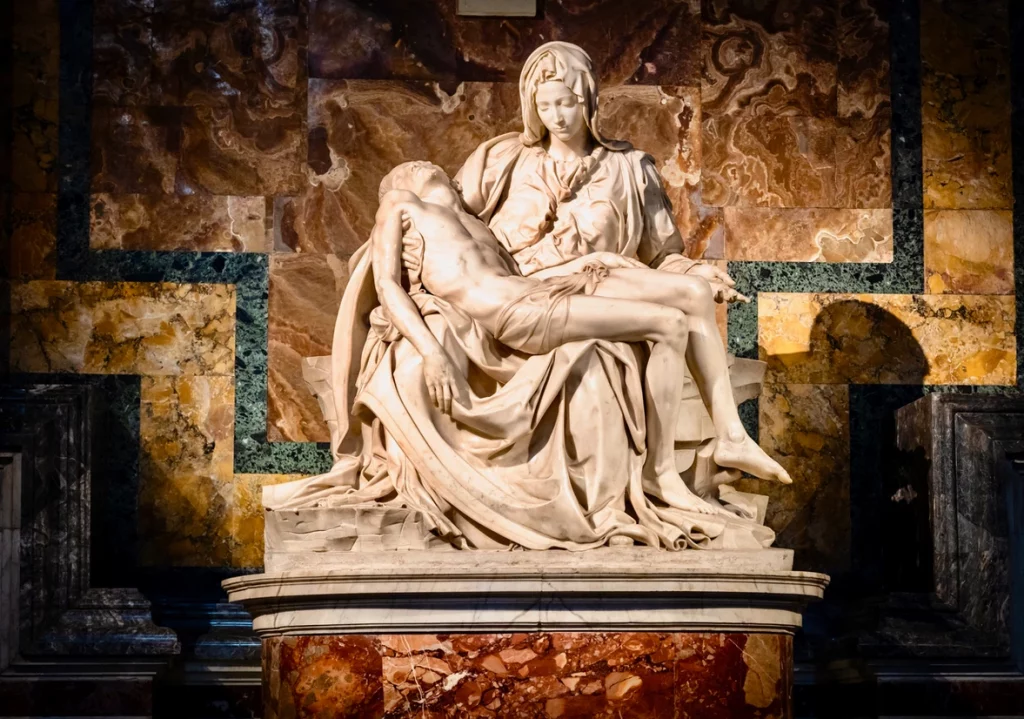
The current basilica was built between 1505 and 1626.
The artists who worked on St. Peter’s Basilica over the years are a veritable who’s who of the Renaissance and Baroque periods.
Repeated design changes were prompted by the push and pull of the popes, who had differing tastes.
Maderno’s central nave is tremendously large, with a lot of glam and glitter. It’s 15,000 square meters and seats 20,000. The vault is supported by 800 columns. There are 45 altars and 450 monumental statues.
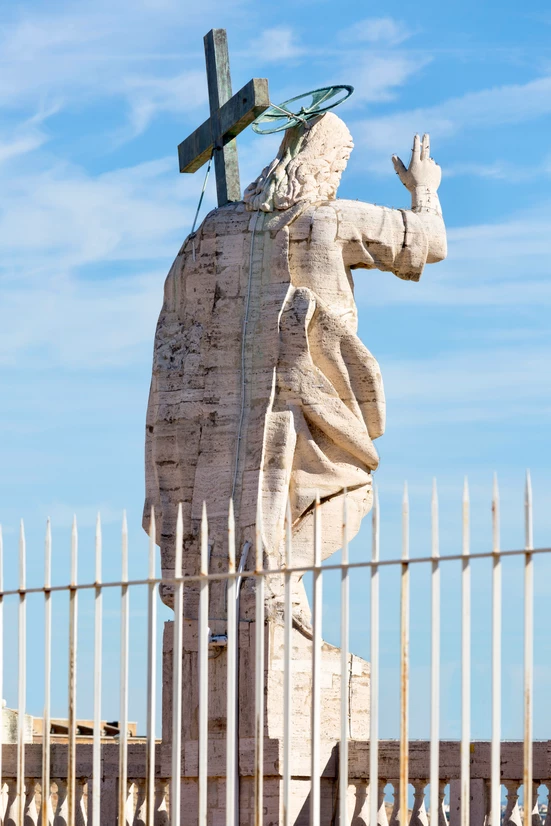
St,. Peter’s is where you’ll find Michelangelo’s tragically beautiful Pieta. The church is also chock full of sculptures by Bernini, the greatest sculptor of the Baroque period, including his famous Baldachin that marks the grave of St. Peter.
READ: Guide To the Bernini Trail in Rome
The dome of St. Peters was designed with input from the revered Michelangelo. It is the tallest dome in the entire world. The basilica is also the burial place of Saint Peter and past popes.
If you climb the dome, you’ll have a bird’s eye view of the nave below. Continue higher to stand on the outside of the dome. This is where you have the iconic view of St. Peter’s Square and a panoramic view of Rome.
Here’s my complete guide to visiting St. Peter’s Basilica. You may want to book a guided tour of the basilica. Or book a guided tour that includes the basilica, a dome climb, and the underground grottos. Alternatively, you can just purchase an audio guide and visit on your own.
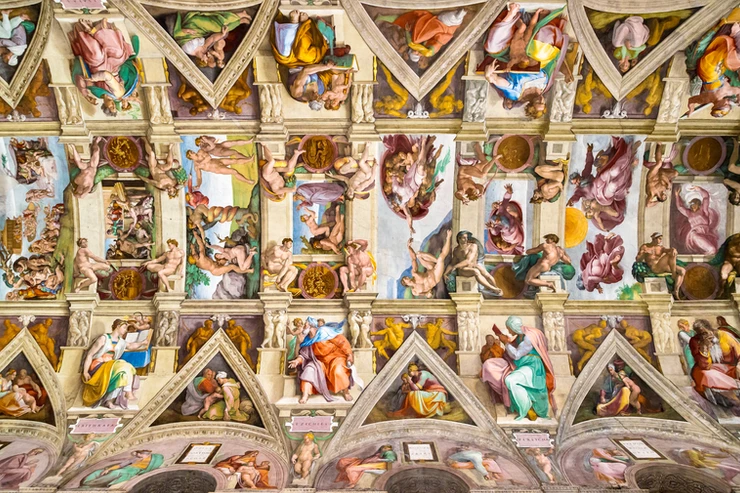
3. The Sistine Chapel
Michelangelo’s Sistine Chapel frescos are the undisputed highlight of a visit to the Vatican. They’re among the most famous paintings in the history of art. 20,000 people visit daily to cast their eyes upward to the glorious ceiling.
Michelangelo spent 4 years toiling away on the 9 ceiling panels, which depict scenes from Genesis and seem to open up the chapel to heaven. And he did it standing up, not laying down as legend holds.
When the Sistine Chapel ceiling was unveiled in 1512, it was somewhat shocking. The frescos were revolutionary in their execution. Instead of staid figures, Michelangelo painted figures that looked like sculptures in almost acrobatic poses. They wear flowing brightly colored garments.
In the middle is Adam, the progenitor of the human race. The Creation of Adam is the most famous Sistine Chapel ceiling scene.
God is depicted as a flying figure acccompanied by a host of angels. Adam looks adoringly at God, waiting for the magic touch. Interpreted as the transmission of life, this touch is the most famous “hand of god” depiction in the world.
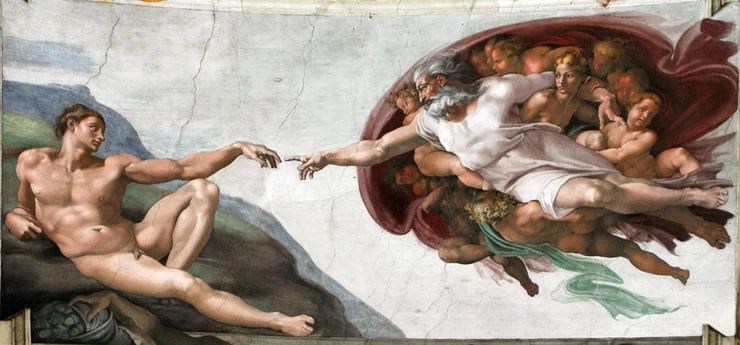
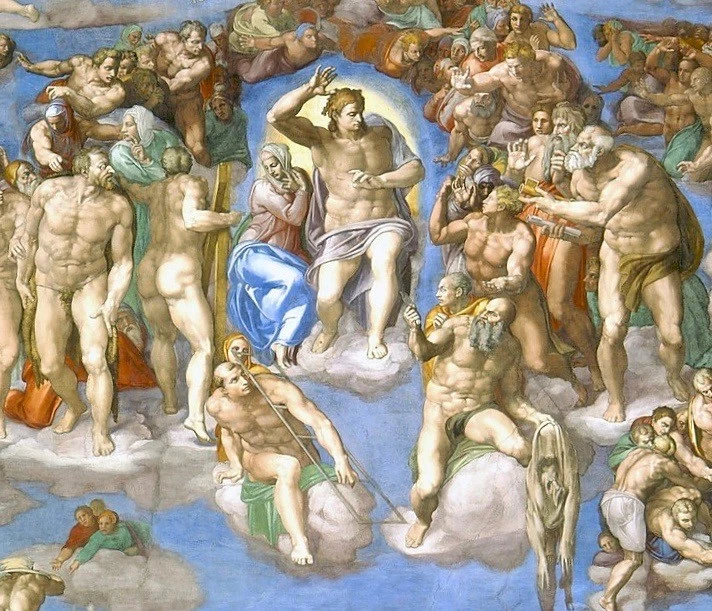
In 1533, Michelangelo made a return visit to the Sistine Chapel. Pope Julius II summoned him to paint The Last Judgment on the altar wall. This time, Michelangelo worked entirely alone, taking 5 years to complete the project.
This fresco is rendered in a different style than Michelangelo’s prior ceiling frescos. The figures are more monumental and the colors are largely monochromatic — essentially sky and flesh tones.
In the middle, Christ is excessively youthful and floats on clouds. He’s depicted more like Apollo than the suffering bearded savior one expects. During the Counter Reformation, underpants were painted on The Last Judgment figures.
In 1980, a serious renovation of the Sistine Chapel began. It took 14 years to clean away the detritus of centuries. The result was a glowing and richly hued Sistine Chapel seen in natural (no longer artificial) light.
Here’s my complete guide to Michelangelo’s frescos in the Sistine Chapel. To see this beauty, you absolutely must pre-book skip the line tickets. Or else you’ll be stuck in line for hours unless it’s the dead of winter. Here’s my complete guide to booking Vatican tickets and tours.
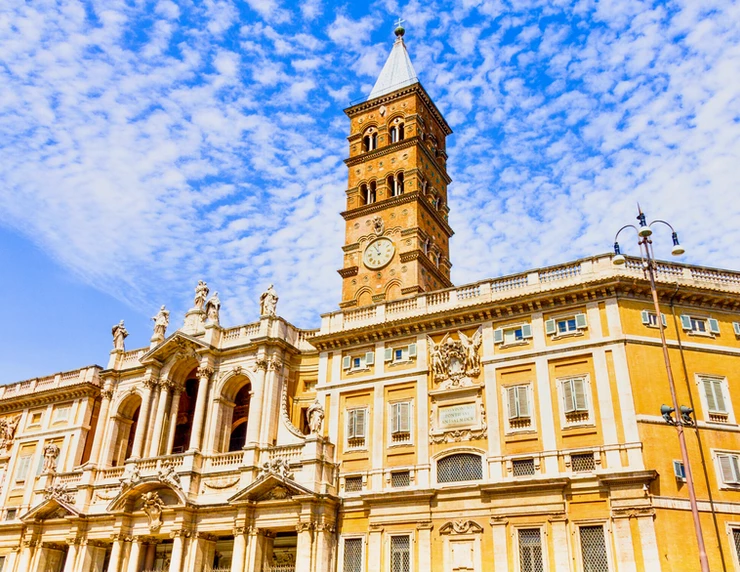
4. Basilica of Santa Maria Maggiore
This beautiful basilica is a UNESCO-listed site in Rome’s Monti area. The basilica dates to the 5th century and is one of Rome’ best must visit churches.
Santa Maria Maggiore is one of four papal basilicas in Rome and retains its original shape (with some embellishments). The basilica was the scene of a miraculous snowfall in the middle of August in the 4th century, which is celebrated annually in a digitized show.
The basilica’s claim to fame is a perfectly preserved Byzantine interior. Beautiful 5th century mosaics decorate both sides of the nave. 13th century mosaics are in the apse.
The basilica also has a stunning coffered ceiling, sculpted by Giuliano da Sangallo in 1450. It’s covered in gold, brought back by Columbus. And there’s a famed relic, five pieces of Jesus’ manger crib downstairs in the Confessio.
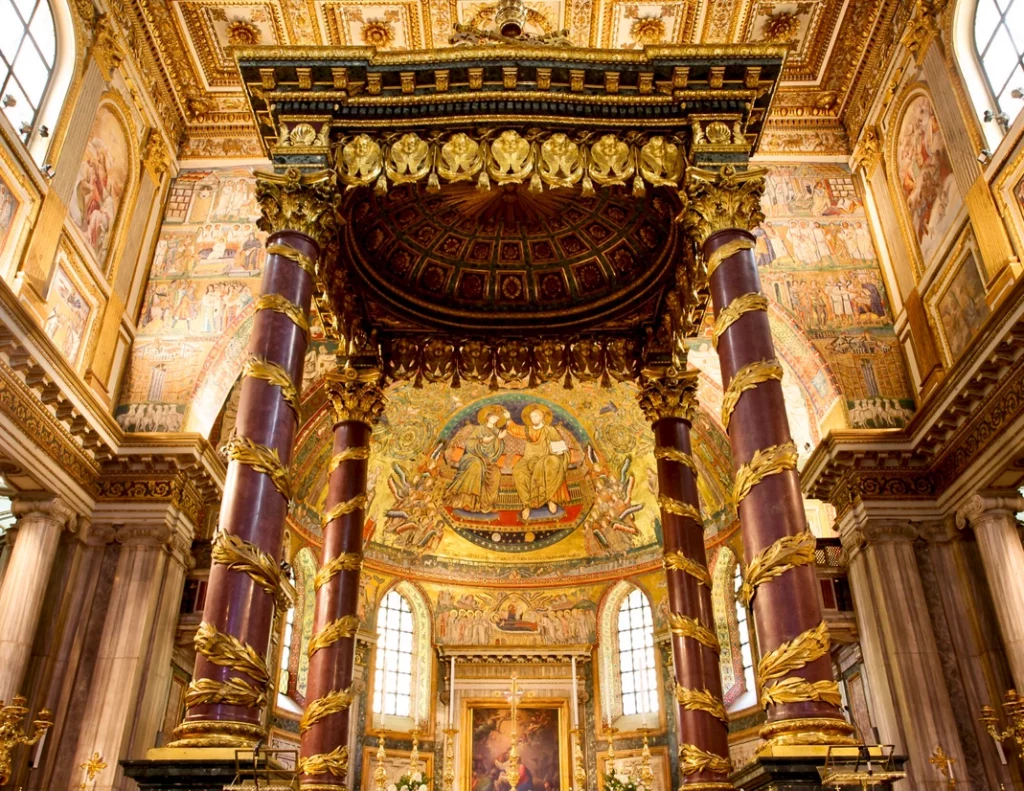
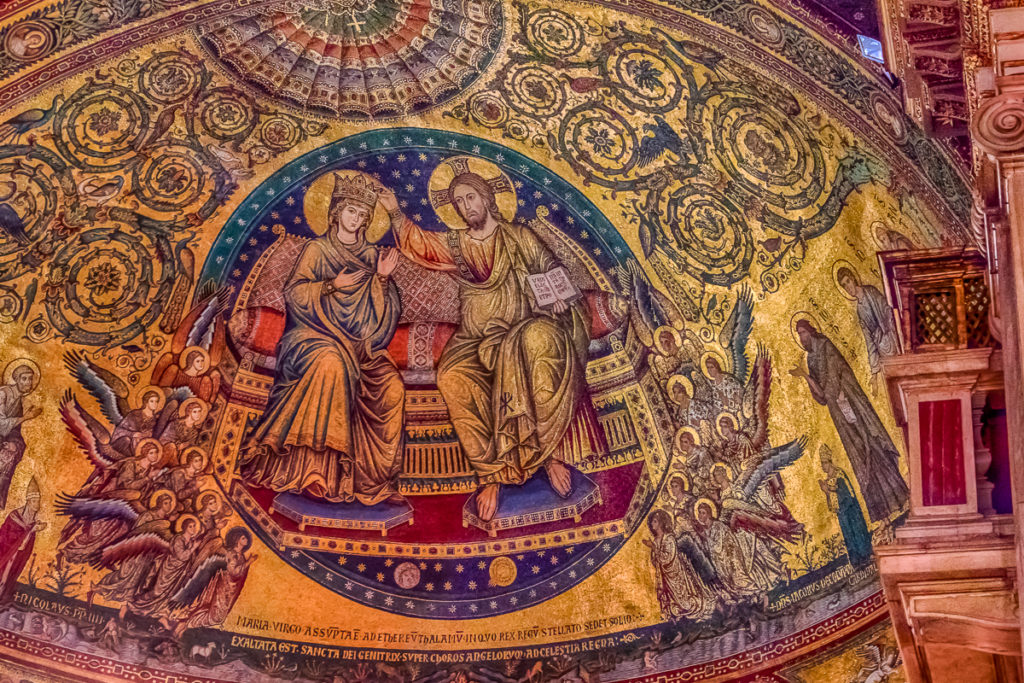
The church is renowned for its magnificent twin chapels, the Sistine Chapel and the Borghese Chapel. The Sistine Chapel has beautiful frescoes, a golden altar, a Bernini statue, and the tomb of Pope Sistus V.
The Borghese Chapel is lavishly decorated and frescoed. It holds one of Rome’s most famous icons, a painting of the Virgin and Child allegedly by Saint Luke, the first Christian painter.
Bernini fans can pay homage to him here, as his tomb is in the church. If you take a guided tour, you’ll get to see a secret spiral staircase designed by Bernini himself. The staircase is an architectural curiosity because there’s no central supporting rail.
Here’s my complete guide to visiting Santa Maria Maggiore. Click here to book a 2 hour guided tour of the basilica.
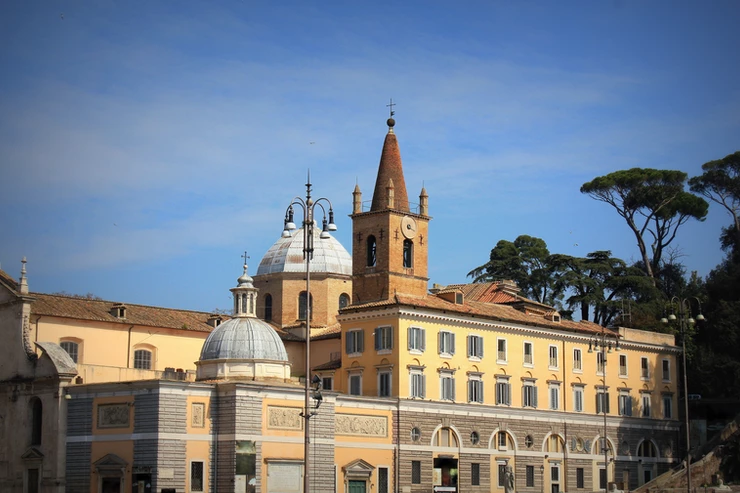
5. Santa Maria del Popolo
Santa Maria del Popolo stands on the northern end of one of Rome’s famous squares, the Piazza del Popolo.
It’s a minor basilica in Rome, run by the Augustinian order. It has an unassuming facade, but inside houses magnificent artistic treasures.
The church has a classic basilica plan — a Latin cross footprint with a nave and two side aisles. There are four chapels in each aisle and a transept with a central dome.
In the 17th century, Pope Alexander VII had Bernini give the church’s nave a Baroque makeover. Bernini designed a rather gaudy main altar.
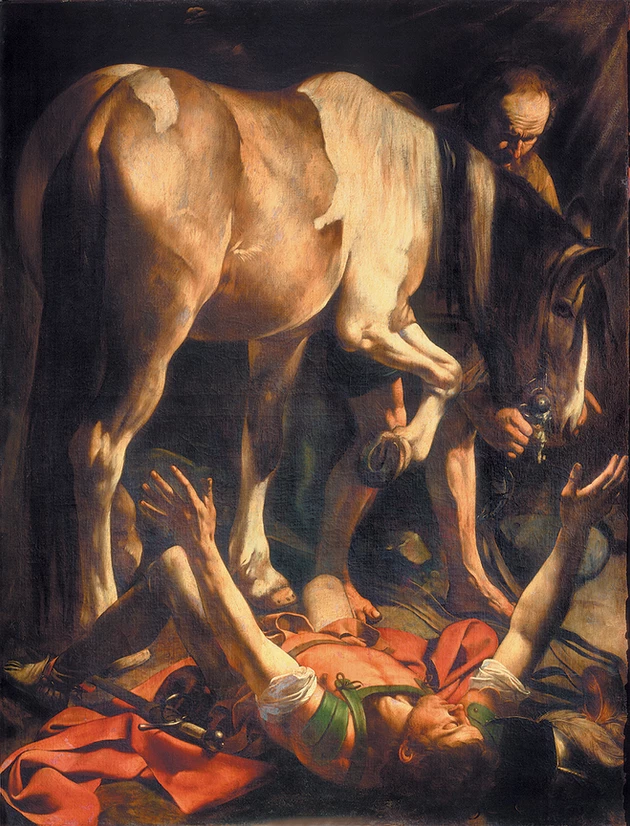
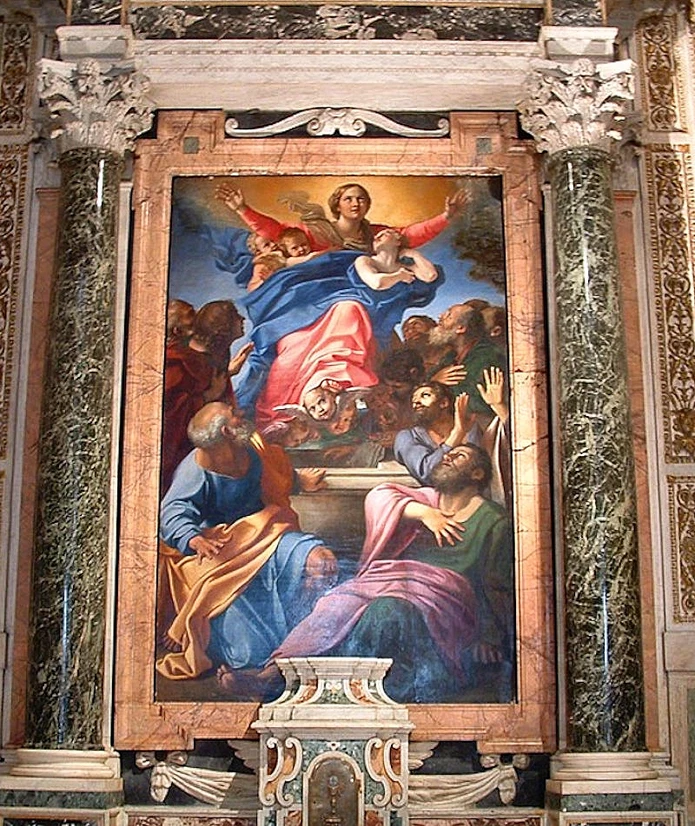
You can find works by the greatest Renaissance and Baroque artists of the day — Caravaggio, Raphael, Bernini, Pinturicchio, and Carracci. The most famous works can be found in the Chigi Chapel and the Cerasi Chapel.
The stunning Chigi Chapel not only features sculptures by Bernini, but has paintings by Caravaggio and mosaics designed by Raphael. The floor mosaic is Bernini’s Winged Death with the Chigi coat of arms.
Sebastian del Piombo created the altarpiece painting between the Bernini sculptures. Del Piombo, a favorite of Michelangelo, used a Michelangelo cartoon to paint the Nativity of the Virgin.
Here’s my complete guide to Santa Maria del Popolo.
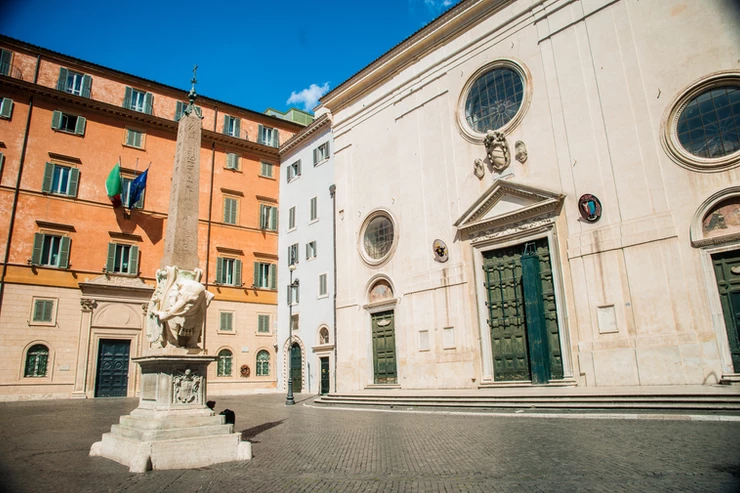
6. Santa Maria Sopra Minerva
Santa Maria Sopra Minerva is just one block from the Pantheon, so you shouldn’t miss an opportunity to peak in. The plain facade belies the treasures inside. The Minerva is a mini-museum, a hidden gem in Rome that’s definitely worth a visit.
The Minerva is Rome’s only Gothic church. The basilica was founded in the 7th century and built over a Roman temple presumably dedicated to Minerva.
At the end of the 13th century, the Minerva was rebuilt in a Gothic style by a Dominican order. They added the classic blue-sky-with-gold-stars vaulted ceiling.
Inside, you’ll find frescos and sculptures by some of the greatest artists of the Renaissance and Baroque, including Michelangelo and Bernini. And a splendid collection of medieval and Renaissance tombs of famous saints, popes, artists, and influential figures.
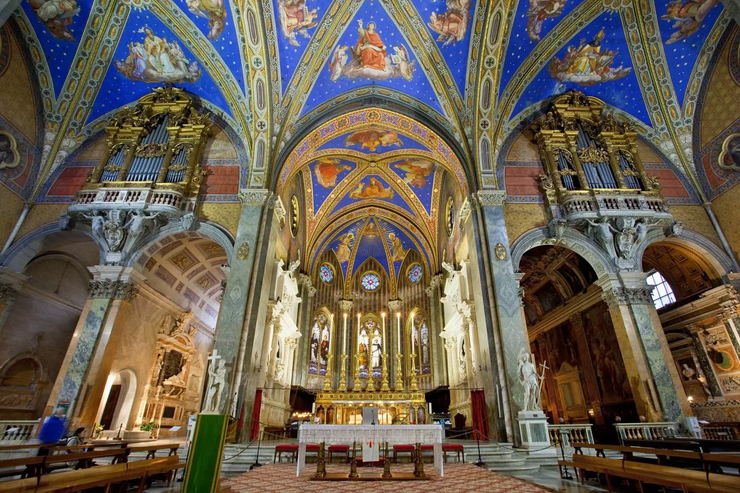
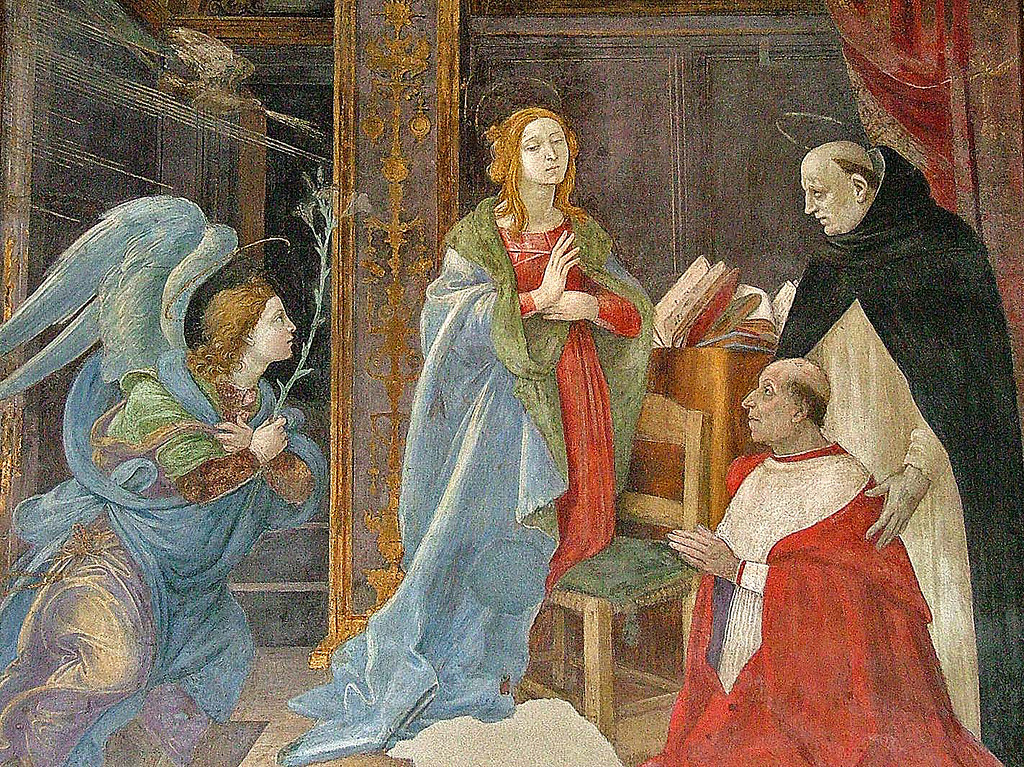
The Carafa Chapel is the undisputed highlight of the Minerva. The chapel is famous for its magnificent 15th century frescos by Filippino Lippi, one of Sandro Botticelli’s best student.
READ: Guide To the Botticelli Trail in Florence
The Carafa Chapel is dedicated to the Virgin Mary and Saint Thomas Aquinas. The most famous of Lippi’s scenes is the wall fresco, The Assumption of Our Lady, above the altarpiece.
It depicts angels carrying Mary upward to heaven. Below The Assumption are the frescos of the life of the Dominican theologian Saint Thomas Aquinas.
Here’s my complete guide to Santa Maria Sopra Minerva. To learn more when you’re in Rome, you can book a guided tour that includes the Minerva and the Pantheon.
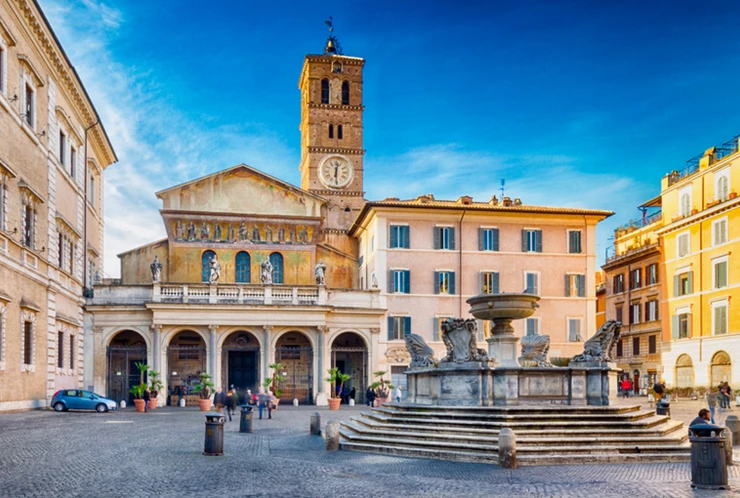
7. Santa Maria in Trastevere
Santa Maria in Trastevere is one of Rome’s oldest churches, built circa 350 AD. It was Rome’s first church dedicated to the Virgin Mary. It’s located in a lively square in the center of Rome’s Trastevere neighborhood.
In the 12th century, Pope Innocent II, a native of Trastevere, rebuilt the church. Like the Basilica of Santa Maria Maggiore, it boasts impressive mosaics from the 12th and 13th centuries.
Adorning the facade are statues of the founders of the church. The campanile or bell tower dates from the 12th century.
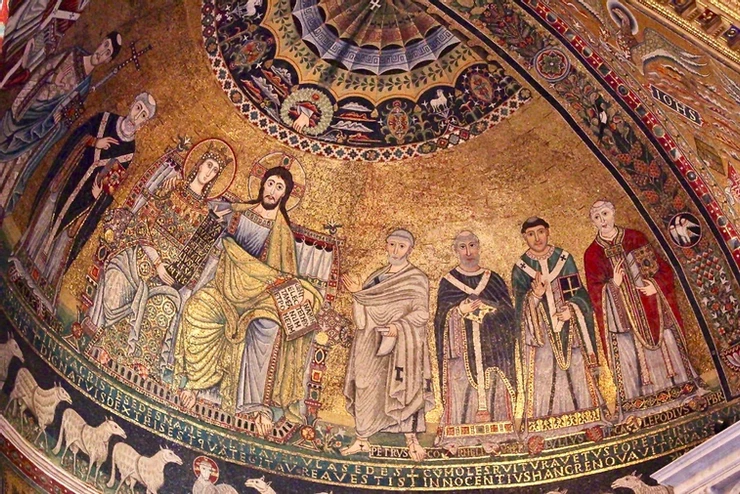
The unique facade mosaics depict wise and foolish virgins, with Mary in the center. Inside, two rows of 22 granite Ionic columns fill the nave. The columns were taken from the ancient Temple of Isis.
The apse in the main altar is covered in gilded 12th century Byzantine style mosaics. The arch mosaic depicts the Enthronement of the Virgin. Be sure to look for the 6 panels known as The Life of the Virgin, created by Pietro Cavallini in 1295.
Cavallini was a forerunner to the more famous Giotto, and one of the first artists to try to break away from the Gothic style.
The floor is made of inlaid Cosamati marble. The ceiling is by Domenichino, from 1617. The panel in the middle shows the assumption of Mary. The style marks the beginning of the Baroque.
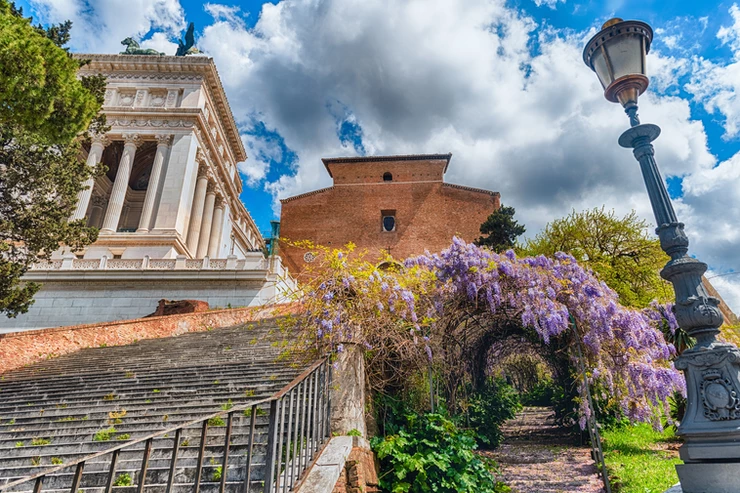
8. Santa Maria in Aracoeli
This is a beautiful church on Capitoline Hill hidden behind an austere brick facade once covered with mosaics. Aracoeli means “altar of heaven.”
The original church dates from the 6th century. But the church you see today is from the 14th century. During the Middle Ages, the church was used as the meeting place for the Roman Senate.
Inside there’s a large nave with 22 ancient granite columns separating the aisles. According to an inscription, one column came from the House of Augustus on Palatine Hill.
The church is mostly known for its beautiful frescos by Pinturicchio, an early Renaissance artist. They’re located in the Chapel of Bernardino of Siena.
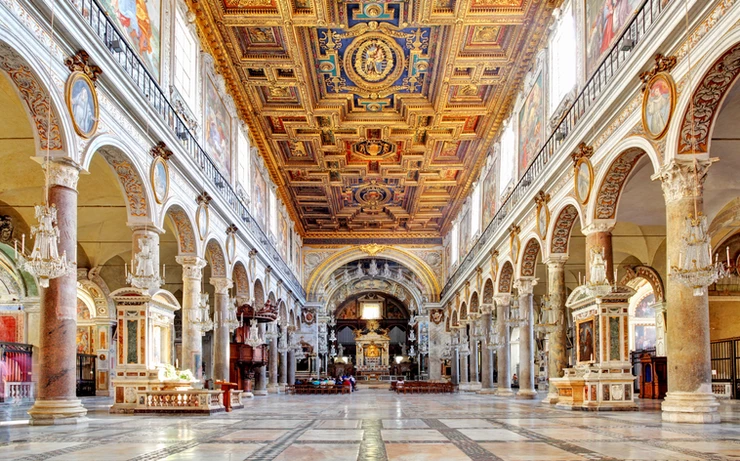
Pinturicchio completed the frescos in 1484 after he had decorated the papal apartments in the Vatican Museums. The frescos have grotesque motifs, based on ancient frescos that had just been discovered in Nero’s Golden House.
The church has a spectacular gilded wooden ceiling, dating from the 16th century. The ceiling commemorates the Christian Victory of Leptano over the muslims.
Other things to look for are the high altar with a Byzantine madonna icon, Bernini’s marble memorial to Pope Urban VIII, a tabernacle by Arnolfo di Cambio, and the tombstone by Donatello.
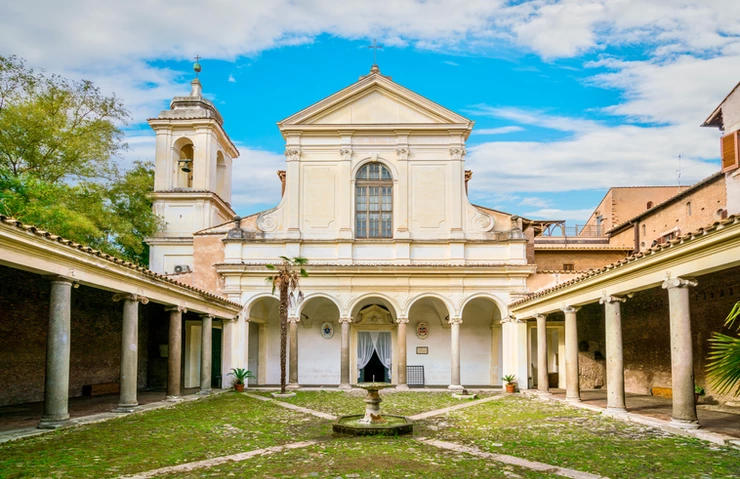
9. Basilica of San Clemente
The Basilica di San Clemente is an 11th century church, built atop a 4th century church, which was built atop an ancient Imperial residence.
It’s a collage of different architectural styles. San Clemente is located in Monti, just a short walk from the Colosseum.
The church is a hidden gem in Rome, perhaps due to its nondescript exterior. It hardly resembles a church. But San Clemente is well worth a visit. It reflects the historical complexity and layers of the city itself.
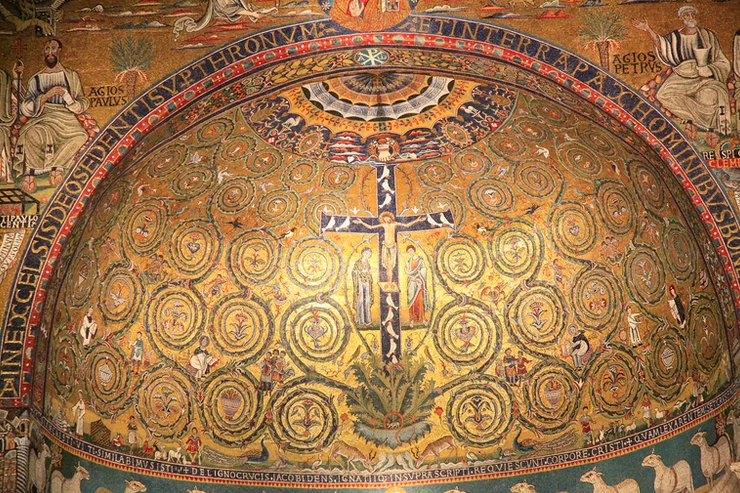
Inside, you’ll see beautifully frescoed ceilings and original gold mosaics in the apse.
But the real treasures lie beneath the inlaid marble floors. San Clemente is one of Rome’s best underground archaeological sites.
Underground, you’ll find layers of Christian history. There are early Christian wall paintings, a 3rd century pagan temple, a 1st century residence, a secret Mithraic worship site, and the Cloaca Maxima (the sewer system of ancient Rome).
Here’s my complete guide to visiting the Basilica of San Clemente.
You can book a 1 hour small group tour or a a 2.5 hour private tour. You can also book a 2 hour guided tour that includes both San Clemente and St. Peter in Chains. St. Peter is where you’ll find Michelangelo’s famous Moses sculpture.
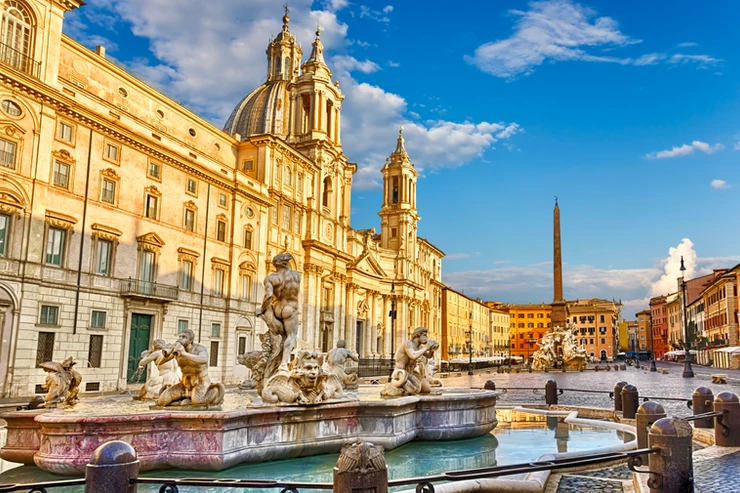
10. Church of Saint Agnes
The beautiful Church of Sant’Agnese was built by Borromini. He was an Italian architect who helped launch Roman Baroque architecture.
Borromini’s works combine classicism with passion. He used concave and convex forms to animate his buildings and eschewed over-decoration.
Sant’Agnese Church in the Piazza Navona is one of his best works. Everyone goes to Piazza Navona and admires the striking concave facade. Most people don’t step inside the church. Do it, it’s free!
The church was commissioned by Pope Innocent X, of the Doria Pamphilj family. It stands on the site of a much older church dedicated to Saint Agnes. According to popular belief, she was martyred on this very spot.
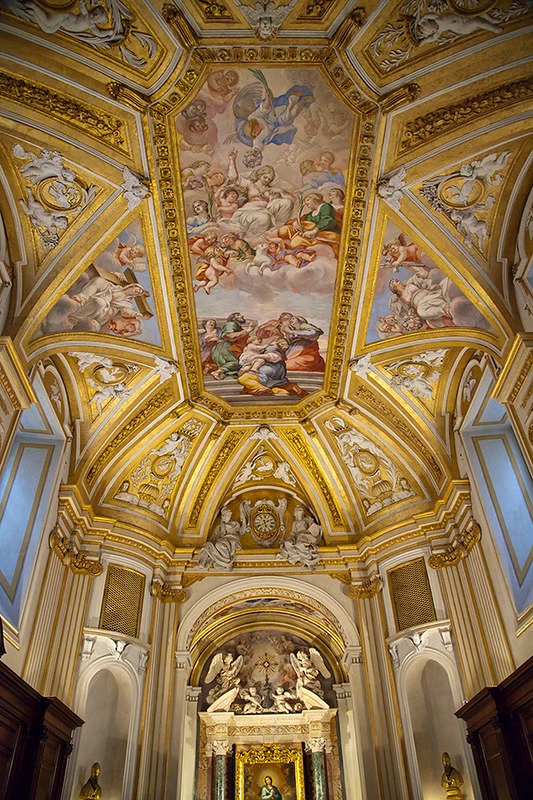
The key element is the concave facade, a design of Borromini’s that revolutionized Baroque architecture. It’s an ingenuous device, which accommodates a small space and allows the church to be seen from anywhere in Piazza Navona.
The facade is made of white travertine limestone with three portals.
Pink and white marble covers the walls inside. The bright and simple interior is filled with Baroque statues. Beautiful frescos decorate the dome.
Here’s my complete guide to Rome’s Sant’Agnese Church.
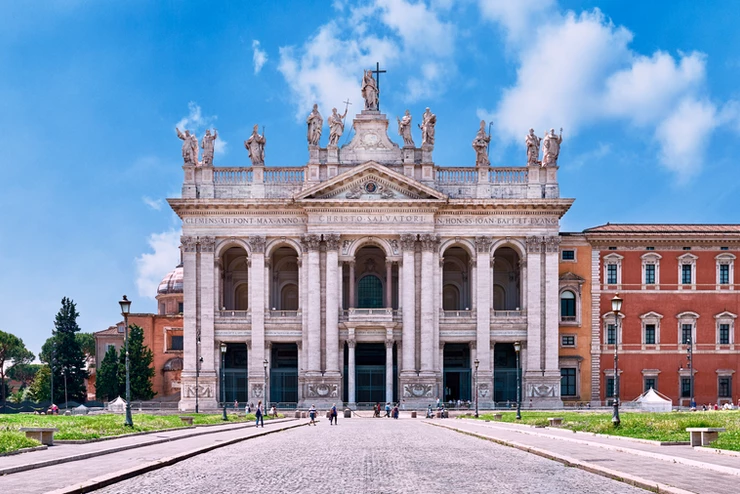
11. Basilica of St. John Lateran | Saint Giovanni of Laterno
The Lateran is one of the four major basilicas under the jurisdiction of the pope. Until 1870, all the popes were crowned here. It houses the tombs of six popes.
The Lateran was the first church established by the Emperor Constantine. Legend holds that Constantine dug the foundation with his bare hands.
A fire destroyed the basilica in 1308. But it was rebuilt by Pope Urban V. The architect Borromini gave the interior a Baroque facelift in the 17th century.
The rather bombastic facade was designed by Alessandro Galilei. It’s made entirely of travertine.
On the top are 15 enormous statues of Jesus, saints, and the doctors of the church, created by the best sculptors of the era. In the vestibule is a massive statue of Constantine.
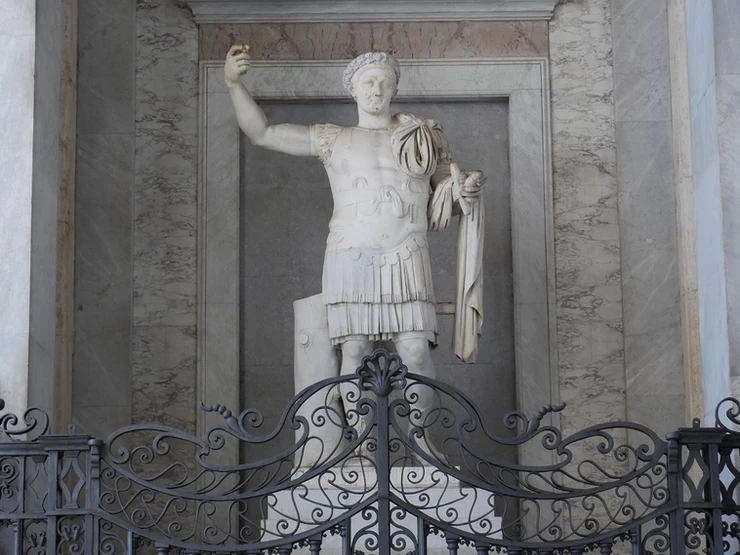
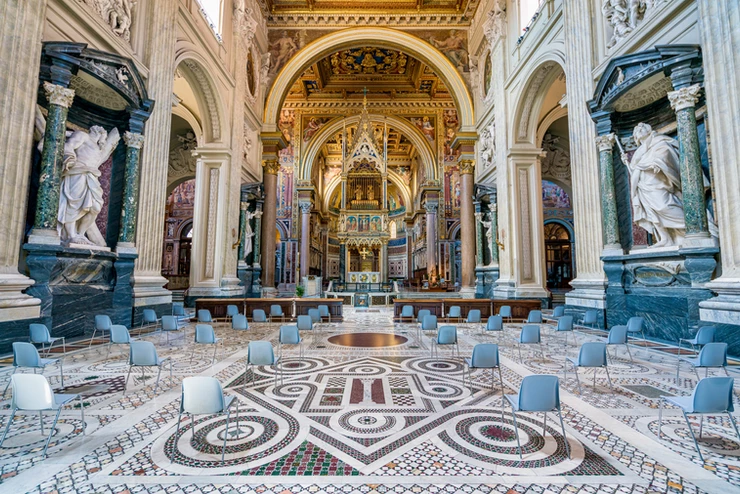
The nave was once a “forest of columns.” Fearing the roof would collapse, Borromini created piers. In each pier is a niche, holding sculptures of the apostles.
The floor is beautiful too. It’s from the 15th century, made of porphyry, serpentine, and granite. There’s also a golden apse mosaic, by Jacobi Torriti, from the 13th century.
The high altar were once used by Saint Peter himself. The baldachin has a 14th century gold canopy with the busts of Paul and Peter. It’s said that the heads of the apostles were actually once with it.
It’s worth it to pay a bit extra to see the 13th century cloister, created by the Cosmati Vassalletti brothers. The cloister has unique twisting double columns.
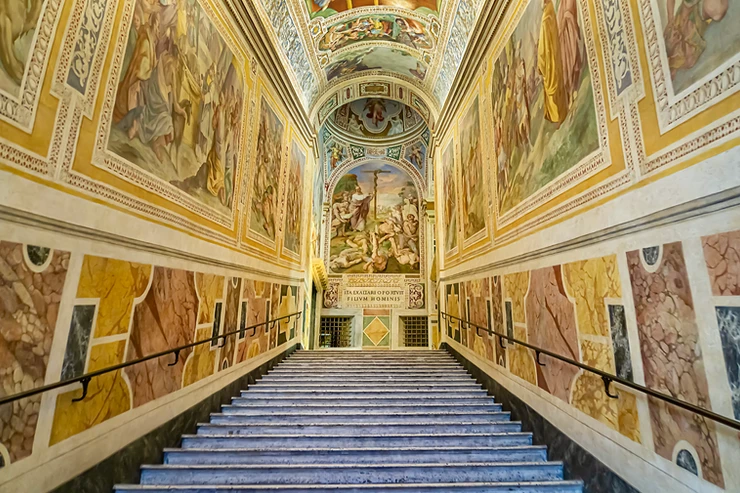
In the cloister you’ll find a beautiful funerary monument by Arnolfo di Cambio and the marble throne once used to crown popes.
Directly across the street from the basilica is the Sanctuary of the Holy Stairs. This is an important stop for pilgrims.
These stairs (with just 28 steps) are renowned because Jesus allegedly climbed them during his passion.
They were reputed to be the marble steps of the house of Pontius Pilate. They were brought back to Rome by Constantine’s mother.
You can book a 2 hour guided tour to see the basilica and the Holy Stairs.
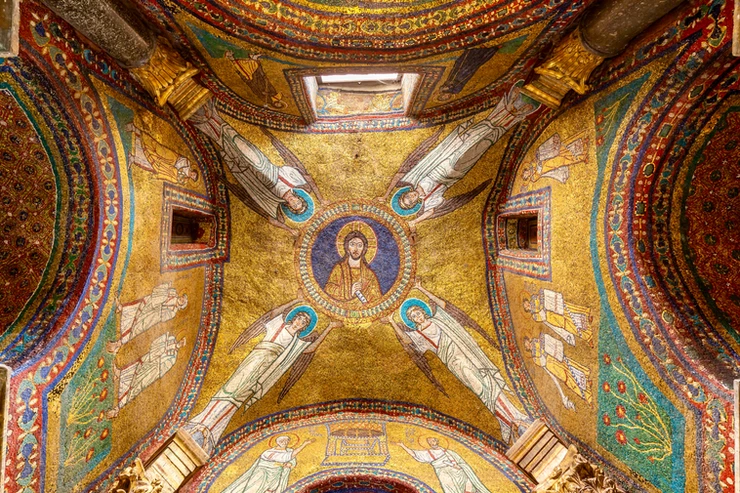
12. Santa Prassede
Built by Pope Paschal, this modest 9th century church is just steps from Santa Maria Maggiore.
The entrance is meager. You have no notion that you’re about to walk into one of Rome’s most important and beautiful churches.
Santa Prassede is an ancient basilica and an important example of Byzantine art in Rome. It’s a wonderful contrast to all the Baroque grandeur.
Inside the church is the usual Cosmatesque floor and ancient Corinthian columns. But the 9th century jewel-like mosaics are the highlight here.
The beautiful Chapel of Saint Xeno is from the 9th century. It’s covered top to bottom with glittering mosaics. In the Middle Ages, it was called the “Garden of Paradise.”
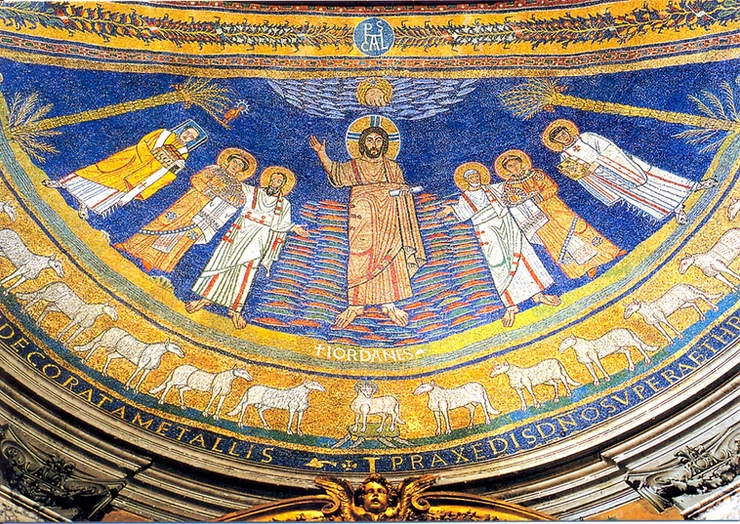
Jesus is in the center of the ceiling, held up by four angels called “Paschal’s Lolitas.” Each angel stands on an ancient Roman column.
The side entrance has a famous row of four women, who seem like a mixture of Roman matron and Byzantine princess.
The wall outside the chapel has a mosaic of Jesus, Mary, and the saints, faces set within circles.
The apse and triumphal arch are also decorated with mosaics. The arch depicts the Heavenly New Jerusalem.
The apse mosaic shows Jesus standing on a hill with an array of saints and Pope Paschal. God’s hand reaches down to touch his crown. Below them are the usual line of lambs on a gold background.
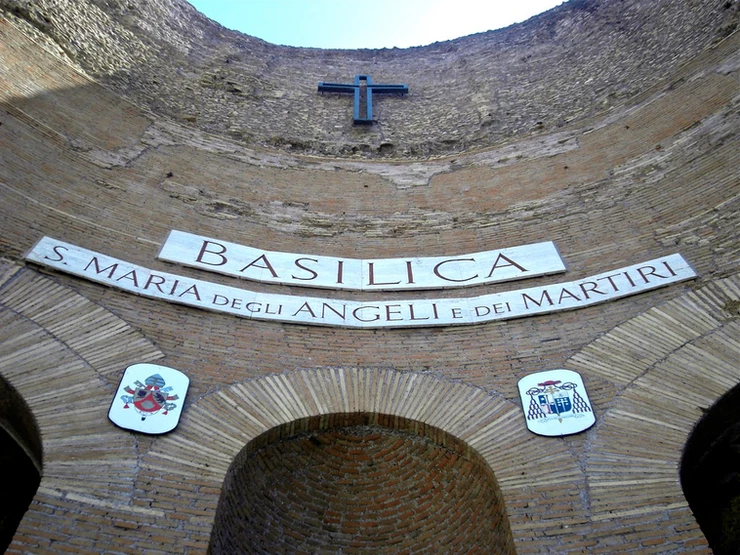
13. Basilica of St. Mary of the Angels and Martyrs
The Basilica of St. Mary of the Anglels is a fascinating church with a facade made of Roman ruins.
It’s a fragment of the frigidarium, or cold pool room, from the ancient Baths of Diocletian. In 1560, Pope Pius IV commissioned Michelangelo to transform the bath ruins into a church. It was to be his final work.
READ: Guide To Ruins in Rome
Romans took their baths seriously. Diocletian’s Baths were meant to surpass the Baths of Caracalla and could accommodate 3,000 citizens.
Stepping inside Michelangelo-designed church gives you an idea of their scale.
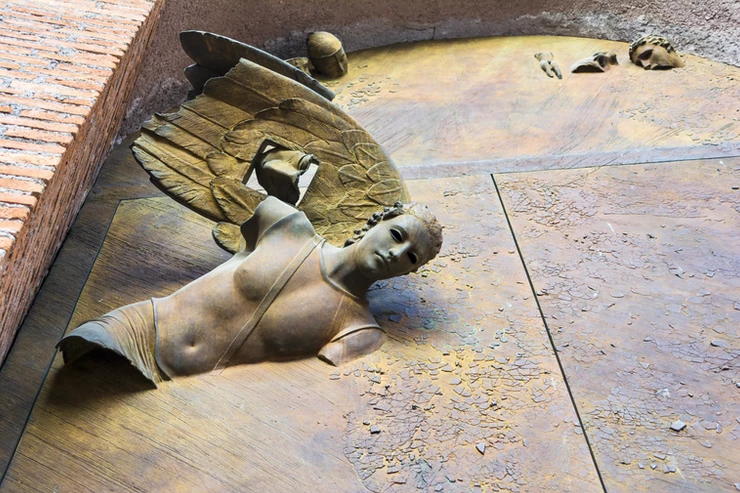
The basilica is the only Renaissance style church in Rome. The sensational interior contrasts sharply with the facade, which Michelangelo intentionally left unadorned except for bronze doors.
The nave boasts massive granite columns, some from the Roman era and some imitations. The church is filled with art, monumental tombs, chapels, and holy relics.
The church is also home to the Meridian of Rome. It was created in 1702 by an astronomer and placed on the church floor in the right transept.
Until 1846, Romans used it to set the time. An opening in the church’s roof causes sunlight to fall on the line precisely at noon.
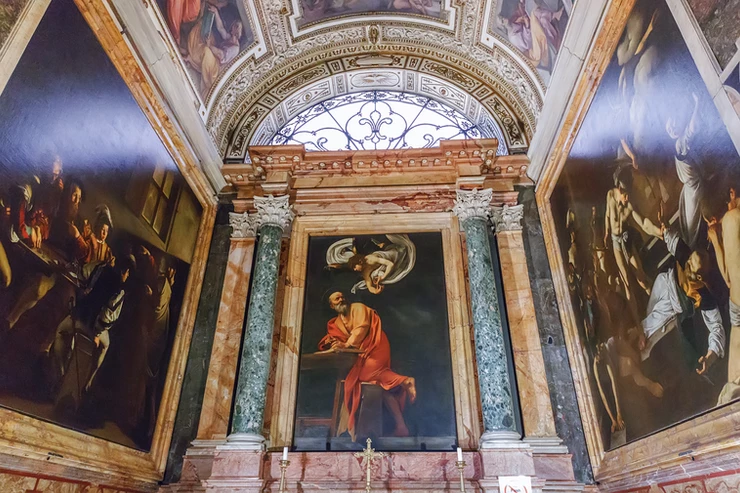
14. Church of St. Louis of the French
This church is officially called San Luigi dei Francesi. It was built between 1523-98 and designed by Giacomo della Porta. It’s home to some world famous frescos and paintings.
The chapel on the right has paintings done by Domenicichini in 1616-17. But the real highlight of the church is to the left — the Contarelli Chapel.
Thanks to his early patron Cardinal Francesco Maria Del Monte, Caravaggio won a major commission for the Contarelli Chapel.
His trio of paintings there made him an overnight sensation in Rome. They depicted Matthew being called by Christ, visited by an angel, and martyred. A slew of stellar commissions followed.
Caravaggio painted the chapel’s biblical scenes as if they were everyday images happening on the rough and rowdy streets of Rome. His paintings were starkly realistic and flood lit. He used chiaroscuro (strong contrasts in light and dark to achieve volume) to dramatic effect.
Here’s my guide to the Carvaggio Trail in Rome. You can also book a 3 hour guided art tour to see Caravaggio’s art in Rome.
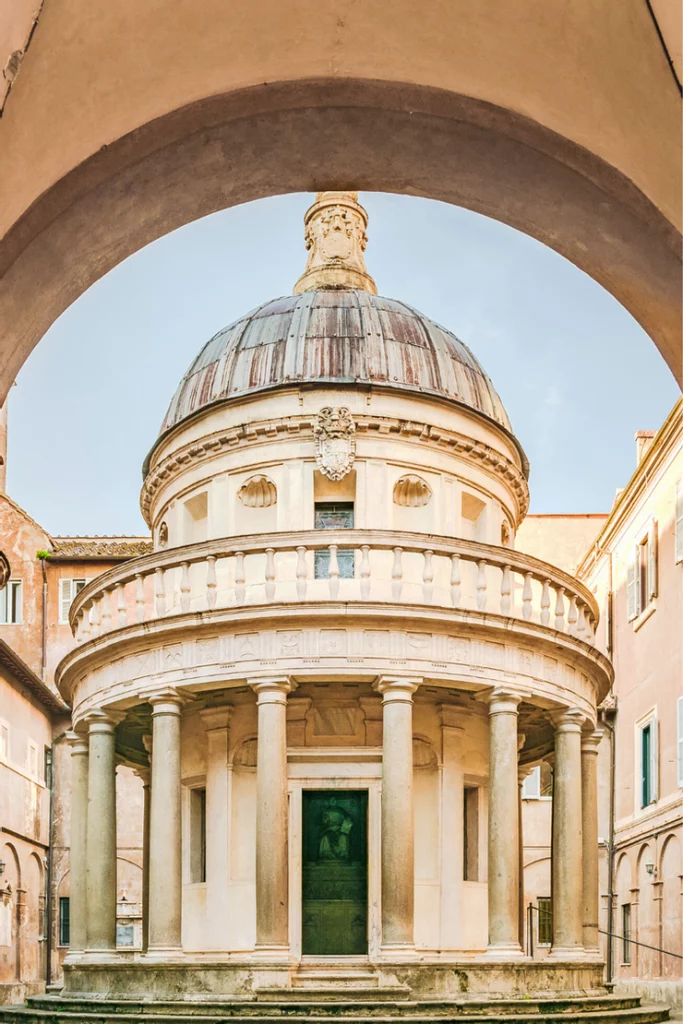
15. Bramante’s Tempietto
If you want to escape Rome’s crowds, take a pleasant walk uphill from the lovely Trastevere neighborhood to the Church of San Pietro in Montorio. This out of the way church once housed Raphael’s Transfiguration before it was moved to the Vatican Museums.
In the church courtyard is a teeny tiny chapel, a church in its own right, made entirely of travertine. Built in 1499, the church is on the spot where St. Peter was martyred. A hole in front of the interior altar marks the exact spot of crucifixion.
Designed by the great architect Donato Bramante, it’s a great example of High Renaissance architecture. It’s one of Rome’s only circular churches and one of Rome’s most beautiful churches.
Ferdinand and Isabella of Spain, named the “Catholic King and Queen” by Pope Alexander VI in 1494, commissioned the Tempietto in memory of their son John. They hired Bramante to build the church and Gian Lorenzo Bernini designed the crypt below it.
The circular temple reinterprets Brunelleschi’s harmonious style. It features Tuscan columns, an ornamental molding with a curved balcony, and a dome. Although one of Rom’’s architectural jewels, the Tempietto is an often overlooked and tourist free gem.
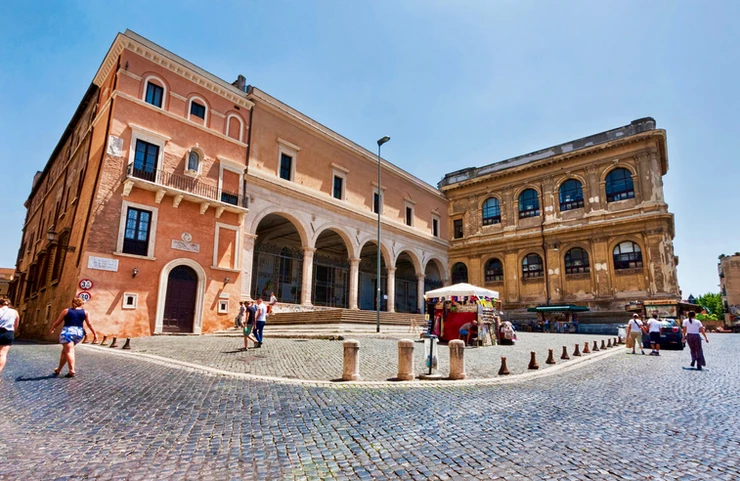
16. St. Peter in Chains
For Michelangelo fans, St. Peter in Chains is a must see site in Rome. Michelangeo was once the world’s greatest sculptor, bending stone and marble to his will. He considered his greatest life work to be Pope Julius II’s tomb.
Despite the fact that the tomb was never completed, you can visit the powerful remains in a historic church that also houses the Apostle St. Peter’s chains. Located in Rome’s Monti neighborhood, the 5th century church is a hidden gem in Rome.
The highlight of the tomb is the imposing 8 feet sculpture of Moses on his throne, from 1516. Michelangelo’s sculpture exudes power. Legend holds that Michelangelo thought Moses was so lifelike that he asked the sculpture to speak. And gave it a ding on the knee when it didn’t.
Aside from Moses, people visit the church to see a valuable relic, the chains of Saint Peter. The Apostle Peter was arrested and jailed in Jerusalem for preaching about Jesus.
He was placed under guard and shackled with an iron chain. The night before his trial, an angel miraculously released St. Peter’s chains and led him out of prison while the guards slept.
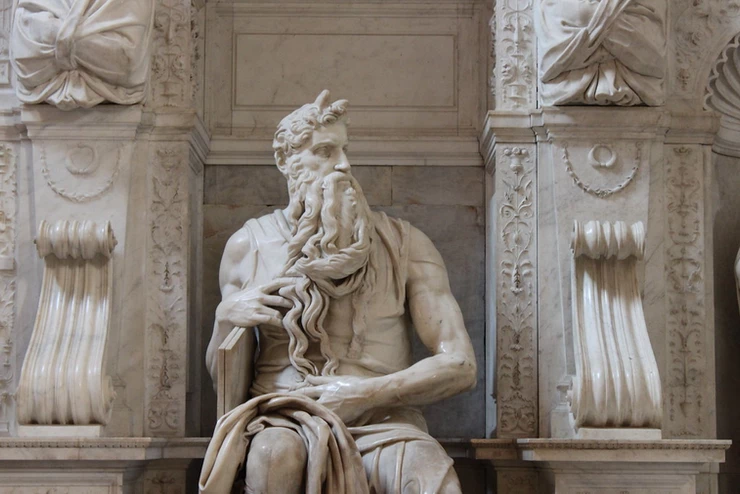
The chains that bound Peter were given to Pope Leo by Empress Eudoxia, the wife of Emperor Valentinian III. According to legend, this chain was miraculously joined with chains from Peter’s previous imprisonment. The pope placed them both in the church.
The chains are now prominently displayed in a golden reliquary under the basilica’s altar. There’s a beautiful painting by Raphael depicting the moment of Peter’s liberation in the Raphael Rooms of the Vatican Museums.
READ: Guide to the Vatican’s Raphael Rooms
I hope you’ve enjoyed my guide to the most beautiful churches in Rome. You may enjoy these other Rome travel guides and resources:
- 3 day itinerary for Rome
- 5 day itinerary for Rome
- Hidden gems in Rome
- Best museums in Rome
- Archaeological sites in Rome
- Guide to the Borghese Gallery
- Guide to Palatine Hill
- Guide to the Roman Forum
- Guide to the Colosseum
If you’d like to visit Rome’s most beautiful churches, pin it for later.

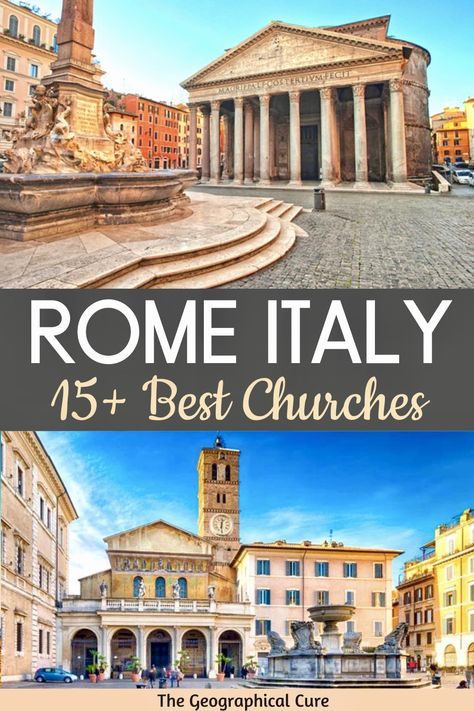
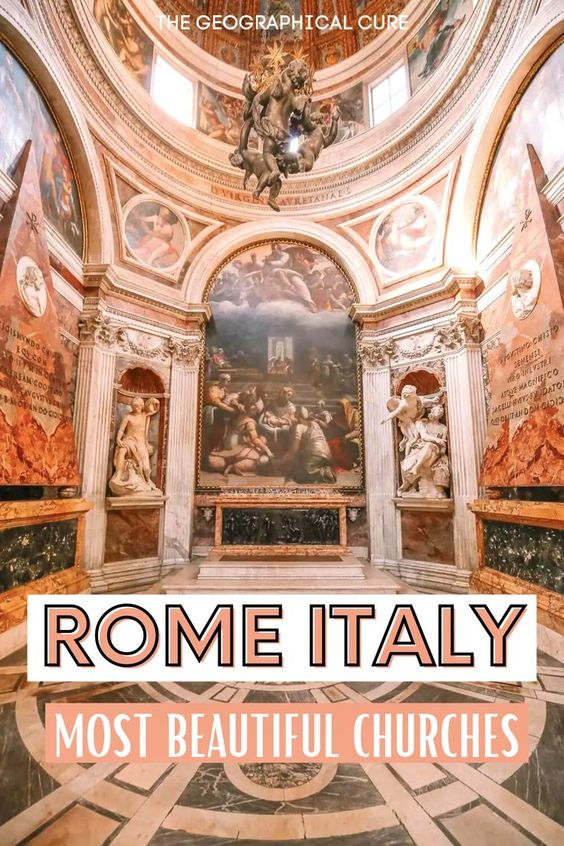
A river of information for anyone to appreciate the art and architecture of churches along the main touristic routes in Rome.
Thank you Carmelo! They are all so well worth visiting for their beauty, art, and architecture.